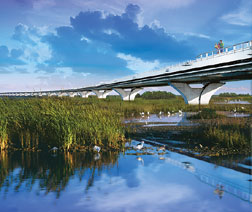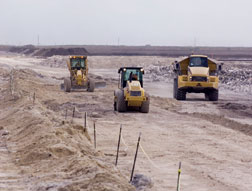 Sierra Club
Everglades Agricultural Area Reservoir (below) will store 190,000 acre-ft of water under comprehensive restoration plan. Everglades Skyway (above) would restore sheet flow by elevating U.S. Route 41.
|
“The new governor, the community affairs director and the [Dept. of Environmental Protection] director have a new ethic,” says Richard Grosso, executive director of the Everglades Law Center Inc. “They are very conscientious about environmental restoration.” Many at the conference echoed the belief that Gov. Charlie Crist (R) has given the state government a new focus on environmental issues since he took office a year ago.
An early sign of the conference’s positive tone was a statement by Lynn Scarlett, assistant secretary of the U.S. Dept. of the Interior, “We are determined to get the Tamiami Trail project moving forward this year.” John Paul Woodley Jr., assistant secretary of the Army for civil works, seconded Scarlett’s comment. He called the project “the single most important thing to move this restoration forward.”
 South Florida Water Management District
|
Unblocking the Flow
Construction of the Tamiami Trail in 1924 was hailed as a major advance for the development of south Florida because it linked the east and west coasts of the peninsula through the Everglades for the first time. But the highway, U.S. Route 41, functions as a dike, blocking the sheet flow of water from Lake Okeechobee south through Everglades National Park. Sheet flow has come to be seen as a key to the ecosystem.
Controversy continues over which of several plans to adopt for demolishing the embankment and elevating the highway, but Scarlett says $80 million has been appropriated and is available to complete design work, acquire right-of-way and begin construction by September 2008. The Army Corps of Engineers is proceeding with design of a project for two bridges totaling three miles with a construction cost estimated in 2005 at $128 million. A coalition headed by the Sierra Club is continuing to advocate a 10.7-mile continuous skyway, whose construction cost was estimated at $278 million.
Action Items
On Jan. 11, the Everglades Coalition, composed of 47 conservation and environmental organizations, released its list of action items for 2008. Federal funding of $370 million to implement Comprehensive Everglades Restoration Plan projects heads the list of five items. The federal government has supplied only $428 million of the 50-50 state and federal partnership under CERP, which became law in 2000. The state, on the other hand, has spent $2.4 billion under the program.
The coalition also called for advancing a suite of projects to restore large volumes of clean water flowing south through the Everglades, specifically including one of the Tamiami Trail modifications known as the Blue Shanty Proposal, restoration uses in the Everglades Agricultural Area and other actions to remove barriers to the sheet flow. Other action items were aimed at completing a study to inform decisions on permits for development, restoring clean-water flows to Florida Bay and aggressive government action to halt soil and water pollution in the Everglades.
More than 400 people attended the conference on Captiva Island, 35% more than last year, says Shannon Andrea, spokeswoman for the National Parks Conservation Association. This was the first Everglades Coalition conference ever in southwest Florida.
nvironmental advocates gathered for the annual Everglades Coalition conference on Jan. 10-13 were buoyed by a parade of state and federal government officials pledging restoration of the endangered south Florida ecosystem. Commitment was evident in both the presence and the expressed determination of the officials to execute plans already formulated to restore the fabled Everglades’ water quality, quantity, distribution and timing.
Post a comment to this article
Report Abusive Comment